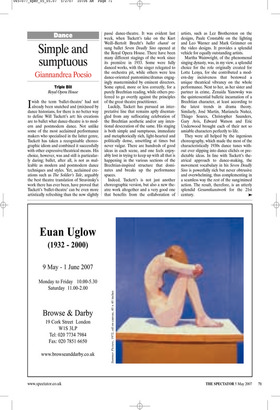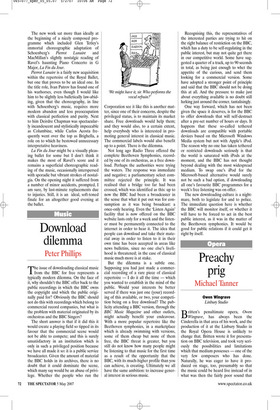Simple and sumptuous
Giannandrea Poesio
Triple Bill
Royal Opera House
Iwish the term ‘ballet-theatre’ had not already been snatched and (mis)used by dance historians, for there is no better way to define Will Tuckett’s art: his creations are to ballet what dance-theatre is to modern and postmodern dance. Not unlike some of the most acclaimed performance makers who specialised in the latter genre, Tuckett has taken a recognisable choreographic idiom and combined it successfully with other expressive/theatrical means. His choice, however, was and still is particularly daring; ballet, after all, is not as malleable as modern and postmodern dance techniques and styles. Yet, acclaimed creations such as The Soldier’s Tale, arguably the best theatre translation of Stravinsky’s work there has ever been, have proved that Tuckett’s ‘ballet-theatre’ can be even more artistically refreshing than the now slightly passé dance-theatre. It was evident last week, when Tuckett’s take on the Kurt Weill–Bertolt Brecht’s ballet chanté or sung ballet Seven Deadly Sins opened at the Royal Opera House. There have been many different stagings of the work since its première in 1933. Some were fully danced works, with the singer relegated to the orchestra pit, while others were less dance-oriented pantomime/dramas engagingly masterminded by eminent directors. Some opted, more or less correctly, for a purely Brechtian reading, while others preferred to go overtly against the principles of the great theatre practitioner.
Luckily, Tuckett has pursued an interpretative line that remains aptly disentangled from any suffocating celebration of the Brechtian aesthetic and/or any intentional desecration of the same. His staging is both simple and sumptuous, immediate and metaphorically rich, light-hearted and politically dense, unsettling at times but never vulgar. There are hundreds of good ideas in each scene, and one feels enjoyably lost in trying to keep up with all that is happening in the various sections of the Brechtian-inspired structure that dominates and breaks up the performance spaces.
Indeed, Tuckett’s is not just another choreographic version, but also a new theatre work altogether and a very good one that benefits from the collaboration of artists, such as Lez Brotherston on the designs, Paule Constable on the lighting and Leo Warner and Mark Grimmer on the video designs. It provides a splendid vehicle for equally outstanding artists.
Martha Wainwright, of the phenomenal singing dynasty, was, in my view, a splendid choice for the role originally created for Lotte Lenya, for she contributed a modern-day incisiveness that bestowed a unique theatrical vibrancy on the whole performance. Next to her, as her sister and partner in crime, Zenaida Yanowsky was the quintessential balletic incarnation of a Brechtian character, at least according to the latest trends in drama theory. Similarly, José Martin, Marianela Nuñez, Thiago Soares, Christopher Saunders, Gary Avis, Edward Watson and Eric Underwood brought each of their not so amiable characters perfectly to life.
They were all helped by the ingenious choreography, which made the most of the characteristically 1930s dance tunes without ever slipping into dance clichés or predictable ideas. In line with Tuckett’s theatrical approach to dance-making, the movement vocabulary in his Seven Deadly Sins is powerfully rich but never obtrusive and overwhelming, thus complementing in a seamless way the rest of the sung/mimed action. The result, therefore, is an utterly splendid Gesamtkunstwerk for the 21st century. The new work sat more than ideally at the beginning of a nicely composed programme which included Glen Tetley’s immortal choreographic adaptation of Schoenberg’s Pierrot Lunaire and MacMillan’s slightly nostalgic reading of Ravel’s haunting Piano Concerto in G Major, La Fin du Jour.
Pierrot Lunaire is a fairly new acquisition within the repertoire of the Royal Ballet, but one that proves to be an ideal one. In the title role, Ivan Putrov has found one of his warhorses, even though I would like him to be slightly less balletically law-abiding, given that the choreography, in line with Schoenberg’s music, requires more modern abandon and less preoccupation with classical perfection and purity. Next to him Deirdre Chapman was spectacularly incandescent and stylistically impeccable as Columbine, while Carlos Acosta frequently went over the top as Brighella, a role on to which he bestowed unnecessary interpretative heaviness.
La Fin du Jour might be a visually pleasing ballet for some but I don’t think it makes the most of Ravel’s score and it remains a superficial choreographic reading of the music, occasionally interspersed with sporadic but vibrant strokes of nostalgia. On the opening night it suffered from a number of minor accidents, prompted, I am sure, by last-minute replacements due to injuries. Still, it is an ideal, soft-toned finale for an altogether good evening at the ballet.



































































































 Previous page
Previous page